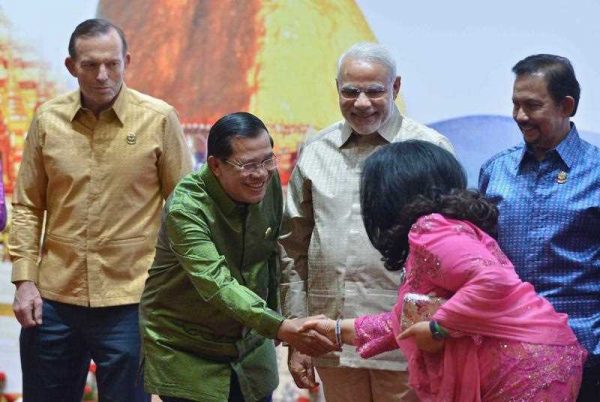At a regional level, the Cambodian government has attempted to pacify Vietnam, which was upset by its continued refusal to criticise China’s growing assertiveness in the South China Sea. This approach was evident in Cambodian Prime Minister Hun Sen’s 2013 visit to Vietnam, when he reiterated the Vietnamese contribution to the 1979 liberation of Cambodia from genocide in front of several Vietnamese senior officials and former veterans.
More importantly, he made his remarks in Vietnamese rather than English, in order to build a personal rapport with the Vietnamese. This is evidence of his attempt to treat Hanoi as a close friend despite the obvious tension, since speaking in Vietnamese wins Hun Sen no favours domestically. Instead, it may strengthen a perception of subordination to the Vietnamese that could further weaken the popularity of his party, which suffered a significant decline in support in the 2013 national election. Many Cambodians harbour strong anti-Vietnamese sentiment and fear further loss of territory to their eastern neighbour, as was the case in the country’s pre-colonial history.
More evidence of Phnom Penh’s intention to develop good ties with Hanoi can be witnessed in the former’s handling of the disputed history of Cochinchina/Kampuchea Krom, which constitutes a major part of today’s southern Vietnam. In 2014 a Vietnamese diplomat stated that the area had historically belonged to Vietnam long before the French officially ceded it to Vietnam in 1949, a statement that outraged Cambodians and triggered a series of anti-Vietnamese demonstrations.
From the Cambodian perspective, the statement was tantamount to an act of historical fabrication regarding the Khmer Kingdom’s Cochinchina, which was steadily absorbed and assimilated by Vietnam’s Nguyen dynasty in the 1620s. Phnom Penh has not taken any diplomatic action requiring Hanoi to clarify this contentious historical interpretation, instead arresting 11 anti-Vietnamese demonstrators in November 2014 in an indication of its intent to prevent a possible diplomatic row with Hanoi.
At a global level, Hun Sen has also attempted to draw closer to China’s regional rivals, Japan and the United States. Following the upgrade of Cambodia–China relations to that of a Comprehensive Strategic Partnership in December 2010 — the highest level of cooperation the Hun Sen government has ever concluded with a foreign government — Phnom Penh also elevated its ties with Tokyo into a ‘strategic partnership’ in December 2013. Further, both Cambodia and Japan have stressed the need for freedom of air navigation in the region, irritating China to an extent.
More recently, in order to encourage Japanese engagement in Cambodia, Hun Sen ordered the printing of a new Cambodian currency note featuring the image of Cambodia’s Tsubasa bridge, which was built by Japanese aid and given a Japanese name. This gesture demonstrates that Phnom Penh’s long-term vision is to engage Tokyo in order to balance its relations with Beijing.
In relation to the United States, Cambodia has become one of the Southeast Asian countries most staunchly in support of combating the Islamic State (IS) in Iraq and Syria. In September 2014, Hun Sen expressed his firm commitment to preventing the harbouring of IS in Cambodia, dismantling IS’s financial activities, and sharing information useful for the United States in fighting the group.
Phnom Penh’s quest for closer ties with Washington is also evidenced by Hun Sen’s strong desire to be a part of the Trans-Pacific Partnership (TPP), designed by Washington to counter Beijing’s influence in the Asia Pacific. During the World Economic Forum on East Asia in April 2015, Hun Sen’s interest in joining the TPP was expressed in his speech as he questioned why the TPP did not include all ASEAN members.
Cambodia’s strategic balancing may at times be precarious, as Cambodia may occasionally opt to side with China, particularly when its larger neighbours — Vietnam and Thailand — present a credible threat to its state security. But this balancing act may be undermined more generally if ASEAN, Japan, and the United States fail to offset the rising economic influence of China in Cambodia, or alternatively if Hun Sen cannot withstand US pressure regarding his handling of human rights and democratic governance problems at home.
Leng Thearith is a PhD Candidate in Political and International Studies at the University of New South Wales at the Australian Defence Force Academy, Canberra.

